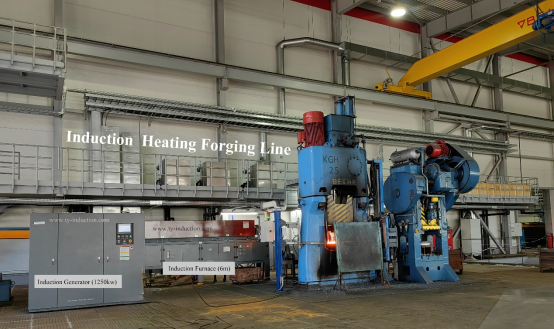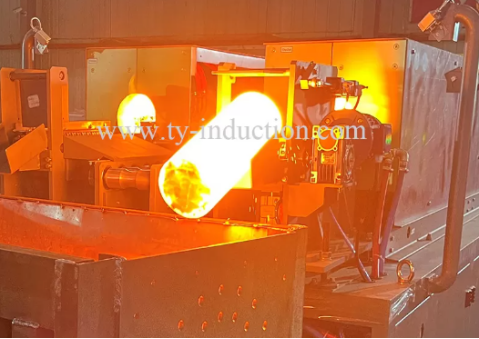Transmission Parts Forging Company Uses Induction Heating to Achieve Rapid Die Change Production
October 27, 2025
A leading transmission parts forging company has successfully integrated induction heating systems into its production line, achieving rapid die change capability while improving overall throughput. By transitioning from conventional gas-fired heating equipment to automated billet heating lines with induction forging heaters, the company has not only reduced downtime during die swaps but also enhanced metallurgical consistency, lowered reject rates, and increased energy efficiency. This move reflects a growing trend in the forging industry, where speed, precision, and sustainability are critical for meeting the demands of modern automotive supply chains.

Transmission components—such as gears, shafts, synchronizers, and shift forks—require precise forging operations to maintain tight dimensional tolerances and meet performance requirements. In traditional forging operations:
Heating billets in gas-fired furnaces or open flames often causes temperature variation across the billet, resulting in inconsistent deformation.
Die changes, particularly for multiple part families, can consume significant production time.
Delays in die swaps can reduce line throughput and increase labor costs.
For transmission parts manufacturers, the ability to heat billets quickly and uniformly while supporting rapid die change sequences is essential to maintain production efficiency, meet just-in-time (JIT) delivery schedules, and ensure high-quality output.
Before adopting induction technology, the forging company faced several obstacles:
Inconsistent billet temperatures: Traditional furnaces caused temperature gradients within billets, leading to uneven grain flow and higher scrap rates.
Extended die change downtime: Heating furnaces often required manual billet staging, which slowed die change processes and extended line idle time.
High energy consumption: Gas-fired heating generated significant heat loss to the surrounding environment, increasing fuel costs.
Operator dependency: Manual monitoring and adjustments were labor-intensive, limiting scalability and responsiveness to production.
These challenges prompted management to evaluate advanced heating solutions that could provide uniform billet temperatures, faster cycle times, and automated integration with forging presses.

The company installed induction billet heaters, induction forging heaters, and a full automated billet heating line to overcome production bottlenecks. Key elements of the upgrade included:
Direct billet heating: Induction coils heat metal billets rapidly and uniformly, reducing temperature deviations compared to conventional furnaces.
Automated material handling: Servo-driven feeders and conveyors synchronize billet flow with forging press operations, minimizing idle time.
Temperature monitoring: Real-time pyrometers and thermocouples ensure precise control for each billet, supporting rapid die change sequences.
Integration with forging presses: The system communicates with presses to ensure billets are ready immediately after a die swap.
1. Reduced Die Change Time
By synchronizing the automated heating line with forging presses, the company shortened die change cycles by up to 25–30%. Heated billets arrive precisely timed for the first stroke after a die swap, minimizing idle press time and enabling continuous production.
2. Improved Material Consistency
Induction heating furnaces maintain uniform core and surface temperatures, ensuring consistent grain flow and reducing microcracks in critical transmission components. This leads to higher dimensional accuracy and lower post-forging machining requirements.
3. Lower Reject Rates
With precise billet temperature control and reduced oxidation, the company has seen a significant drop in defects such as surface cracks, incomplete filling, and material brittleness. Overall reject rates declined by over 20%, translating to material savings and higher throughput.
4. Faster Cycle Times
Induction systems heat billets much faster than gas-fired furnaces, reducing preheating time and enabling the production line to accommodate multiple die changes per shift without bottlenecks.
5. Energy Efficiency and Sustainability
Induction heating targets energy directly to the billet, reducing heat loss and energy consumption. This also lowers CO₂ emissions and supports compliance with environmental regulations.
Automated hot forming induction lines reduce manual handling of billets, improving operator safety and reducing workplace heat exposure. Operators can focus on process monitoring and quality control rather than physically moving heavy billets. Additionally, induction heating eliminates the need for open flames, decreasing fire risks and ventilation requirements.
Though the initial investment in forging heating equipment is higher than traditional gas furnaces, the return on investment is rapid:
Reduced scrap and rework costs
Increased die longevity due to stable billet temperatures
Faster production and better utilization of forging presses
Lower fuel and maintenance costs
The combination of operational efficiency and sustainability improvements makes induction heating systems economically compelling for transmission parts manufacturers.
Q1: What is the difference between an induction billet heater and a conventional furnace?
A1: An induction billet heater heats metal directly via electromagnetic fields, providing rapid, uniform temperature control. Conventional furnaces rely on ambient heat, which can cause uneven heating, slower ramp-up, and oxidation.
Q2: How does induction heating support rapid die changes?
A2: Automated hot forming induction lines ensure billets are ready at precise temperatures exactly when a new die is installed. This reduces idle press time and allows multiple die changes within a shift without production delays.
Q3: What materials can be processed with induction forging heaters?
A3: Induction systems are compatible with various steels used in transmission components, including carbon steel, alloy steel, and high-strength steels, with programmable settings for diameter, length, and steel grade.
Q4: Are induction heating systems energy-efficient?
A4: Yes. By focusing energy directly on the billet, induction heating furnaces minimize heat loss, lower electricity or fuel consumption, and reduce CO₂ emissions compared to gas-fired methods.
Q5: Can induction heating lines integrate with existing forging presses?
A5: Absolutely. Modern automated billet heating lines are designed for seamless integration with press automation systems, including sensors, conveyors, and PLCs, enabling synchronized operation and data tracking.
Q6: What maintenance is required?
A6: Routine maintenance includes inspection of induction coils, calibration of temperature sensors, and preventive checks on automation components. Training ensures consistent operation and rapid troubleshooting.
To support transmission parts manufacturers in achieving faster, more reliable production, TY INDUCTION provides state-of-the-art induction heating solutions. Their offerings include:
Automated billet heating lines
Hot forming induction lines
With precise temperature control, seamless integration with forging presses, and energy-efficient operation, TY INDUCTION helps companies reduce die change downtime, lower reject rates, and improve delivery speed while complying with environmental standards. Manufacturers can rely on TY INDUCTION for turnkey installation, training, and ongoing technical support.
Hot Products
Contact Us
Enquiry hotline:
+86 135 4128 7190
Email:
Address:
No.18,14th Floor, Building 2, No. 169 Zhongli Road, Banzhuyuan Subdistrict, Xindu District, Chengdu, Sichuan, China, Code:610000
